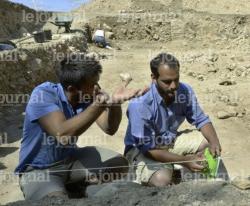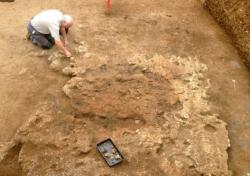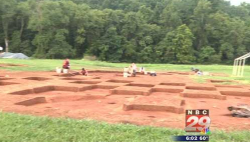INSTITUT SUPERIEUR D'ANTHROPOLOGIE
INSTITUTE OF ANTHROPOLOGY
ONLINE COURSES / COURS A DISTANCE
FALL TERM : OCTOBER 2013
REGISTER NOW
RUSSIE –  Irkutsk - Coal company workers in Eastern Siberia have uncovered the final resting place of a 13th-century Mongolian warrior while digging near the city of Irkutsk, the Russian Interior Ministry’s local branch said Friday. Upon hearing that a skeleton had been discovered on his company’s property, the director of Yevrougol (“Euro Coal”) called police, who came to the scene and determined that the remains should be viewed by officials from the service for the preservation of cultural heritage. Archaeologists believe that the uncovered “skull, bones and ammunition belong to a Mongolian warrior dating back to the 13th century,” police said in a statement. Eight flat metal pieces resembling arrow heads, a fragment of a stirrup and leather items were discovered around the bones, the statement said. At its peak around 1270, the Mongol Empire was the largest contiguous empire to ever appear in human history. Similar graves also have been discovered in Eastern Siberia.
Irkutsk - Coal company workers in Eastern Siberia have uncovered the final resting place of a 13th-century Mongolian warrior while digging near the city of Irkutsk, the Russian Interior Ministry’s local branch said Friday. Upon hearing that a skeleton had been discovered on his company’s property, the director of Yevrougol (“Euro Coal”) called police, who came to the scene and determined that the remains should be viewed by officials from the service for the preservation of cultural heritage. Archaeologists believe that the uncovered “skull, bones and ammunition belong to a Mongolian warrior dating back to the 13th century,” police said in a statement. Eight flat metal pieces resembling arrow heads, a fragment of a stirrup and leather items were discovered around the bones, the statement said. At its peak around 1270, the Mongol Empire was the largest contiguous empire to ever appear in human history. Similar graves also have been discovered in Eastern Siberia.
http://en.rian.ru/russia/20130823/182931541/13th-Century-Mongolian-Warrior-Found-in-Siberia.html
FRANCE –  Autun - Depuis le début de l’été, une campagne de fouilles archéologiques est conduite à Autun à proximité du temple dit « de Janus ». Le chantier se situe à la confluence des rivières Ternin et Arroux, à quelques centaines de mètres de l’enceinte de l’ancienne Augustodunum, capitale des Eduens à l’époque romaine. Le site abritait alors un vaste espace cultuel dominé par la masse imposante du temple dit « de Janus » dont la tour centrale est encore en élévation. A côté du temple, un théâtre d’un diamètre estimé à près de 134 m (ce qui en fait l’un des plus importants de Gaule) a été révélé en 1975 lors de prospections aériennes. Il fait l’objet depuis la mi-août d’une étude de trois semaines sous forme de chantiers-écoles de fouilles coordonnés par le service archéologique d’Autun. Les murs en élévation mis à jour par les archéologues sont dans un remarquable état de conservation, ce qui renforce le caractère exceptionnel de ce site archéologique de tout premier ordre.
Autun - Depuis le début de l’été, une campagne de fouilles archéologiques est conduite à Autun à proximité du temple dit « de Janus ». Le chantier se situe à la confluence des rivières Ternin et Arroux, à quelques centaines de mètres de l’enceinte de l’ancienne Augustodunum, capitale des Eduens à l’époque romaine. Le site abritait alors un vaste espace cultuel dominé par la masse imposante du temple dit « de Janus » dont la tour centrale est encore en élévation. A côté du temple, un théâtre d’un diamètre estimé à près de 134 m (ce qui en fait l’un des plus importants de Gaule) a été révélé en 1975 lors de prospections aériennes. Il fait l’objet depuis la mi-août d’une étude de trois semaines sous forme de chantiers-écoles de fouilles coordonnés par le service archéologique d’Autun. Les murs en élévation mis à jour par les archéologues sont dans un remarquable état de conservation, ce qui renforce le caractère exceptionnel de ce site archéologique de tout premier ordre.
http://www.lejsl.com/edition-d-autun/2013/08/23/depuis-le-debut-de-l-ete-une-campagne-de-fouilles-archeologiques-est-conduite-a-autun-a-proximite
ROYAUME UNI –  Sedgeford - In Saxon times, Sedgeford lay south of the river. SHARP’s original focus was a riverside graveyard mysteriously abandoned in Norman times but preserved in old mother’s threats to naughty children “you’ll be sent to the boneyard with the dead folk”. This ‘boneyard’ yielded Saxon burial and cremation – and a Viking woman buried with a horse – and a late Saxon murder scene: a large healthy male with fatal wounds still etched into the skeleton by a Viking marauder, now an exhibit, as well as a crouch-burial dating from the Bronze Age. Current excavations are of the ‘living space’ atop the hill. Though north-facing, this Sedgeford was sheltered from the prevailing wind and in the days of wattle and daub walls and thatched roofs – pole marks of these in the wattle are still visible – shelter may have weighed with locals as much as Conservation Area status does today. The find of the season is an industrial-scale oven (pictured) - with a Mid-Saxon handprint preserved in the hardened clay – set outside the village because of the fire-danger sparks and flames posed to thatched roofs. The rich Saxon soil it rests in puts ours to shame.
Sedgeford - In Saxon times, Sedgeford lay south of the river. SHARP’s original focus was a riverside graveyard mysteriously abandoned in Norman times but preserved in old mother’s threats to naughty children “you’ll be sent to the boneyard with the dead folk”. This ‘boneyard’ yielded Saxon burial and cremation – and a Viking woman buried with a horse – and a late Saxon murder scene: a large healthy male with fatal wounds still etched into the skeleton by a Viking marauder, now an exhibit, as well as a crouch-burial dating from the Bronze Age. Current excavations are of the ‘living space’ atop the hill. Though north-facing, this Sedgeford was sheltered from the prevailing wind and in the days of wattle and daub walls and thatched roofs – pole marks of these in the wattle are still visible – shelter may have weighed with locals as much as Conservation Area status does today. The find of the season is an industrial-scale oven (pictured) - with a Mid-Saxon handprint preserved in the hardened clay – set outside the village because of the fire-danger sparks and flames posed to thatched roofs. The rich Saxon soil it rests in puts ours to shame.
http://www.lynnnews.co.uk/news/local/latest-local-news/a-season-of-discovery-for-sedgeford-archaeological-digs-1-5420824
ROYAUME UNI – Winchester - They are hoping to reveal century’s old secrets hidden beneath the ground. Winchester Archaeology and Local History Society (WARG) kicked off their big dig yesterday (Aug 22) at St Cross Hospital in Winchester. The excavation is to look for a lost building that may have become submerged over the centuries and could have been part of the original Hospital founded by Henry of Blois in 1132. WARG has dug previously at St Cross and discovered the building in 2009 but it was not possible to explore thoroughly because it is under the Bowling Green, used for wedding receptions and other events.
http://www.hampshirechronicle.co.uk/news/10634670.Big_Dig_starts_in_Winchester_to_find_lost_ancient_building/
TURQUIE – Limantepe - Work has begun to unearth and exhibit ship remains from different eras that were discovered during an underwater excavation in the ancient town of Limantepe (Greek Klazomenai) on Turkey's western coast, as Anadolu Agency reported. It has been 13 years since the underwater excavations started in Limantepe, a site that attracted the interest of researchers when they could not initially identify areas in the sea on aerial photographs of the skele neighborhood in the district of Urla. Twenty underwater archaeologists, under the direction of Professor Hayat Erkanal, are taking part in the excavations in Limantepe, the site of a prehistoric settlement which witnessed humanity's passage from being hunter-gatherers to farmers. Klazomenai or Clazomenae was an ancient Greek city on the coast of Ionia and a member of the Ionian League. It is thought that an earthquake or other cataclysmic event that took place in the sixth-century B.C. submerged the port. The excavations, coordinated by the Ankara University Underwater Research and Application Center (ANKUSAM), are continuing on the base of the port that dates back to the seventh-century B.C. Erkanal has reported that they discovered many ship remains from different eras and items that came out of these ships, which have been desalinated in a laboratory in preparation for exhibition. The harbour of ancient Klazomenai encompasses a vast region underwater, meaning excavations are likely to continue in the upcoming years, said Erkanal. Of the many ship remains found, a vessel from the seventh-century B.C. and an 18th-century Ottoman warship were taken into complete preservation underwater, according to Erkanal. Another ship was also discovered by fishermen 400 meters from the excavation site at a depth of 17 meters.
http://www.ansamed.info/ansamed/en/news/sections/culture/2013/08/26/Archaeology-ancient-shipwrecks-found-off-Turkish-coast_9200476.html
USA – Indiana - The French influence on state history is the focus of Indiana Archaeology Month in September. Archaeologists have recorded more than 60,000 archaeological sites in Indiana since the early 1800s, helping shape public understanding of the state's past. State Historic Preservation Officer Cameron Clark archaeology month provides a way for Indiana residents to discover the pathway to who Hoosiers are today. French fur traders and missionaries who canoed or otherwise traveled along the Wabash and other Indiana rivers and forests were the main European presence in the area beginning in the mid-1600s to early 17th century, when they helped build frontier outposts that later became cities such as Vincennes, Lafayette and Fort Wayne.
http://www.greenfieldreporter.com/view/story/53f59583c99046d6a5e47bf6fb9ec28e/IN--Archaeology-Month
GEORGIE –  Sakdrissi - Ce site minier préhistorique est situé sur le site de la Butte de Kachagiani, à 50 km de Tbilissi, la capitale géorgienne. Le site a été découvert en 2004 et il s’agit de la plus vieille mine d’or connue. Depuis 2006, le site était classé et par conséquent protégé par la législation géorgienne. Mais Sakdrissi est toujours une zone minière importante et la pression économique s’est accentuée. Récemment, en juin, une commission a rédigé un rapport afin d’invalider les assertions et découvertes de nos collègues archéologues menant des recherches sur le site. La mine d’or serait selon eux une mine de cuivre de l’Age du Bronze, ce qui est courant en Georgie et ne présenterait donc pas d’intérêt particulier. Par conséquent Sakdrissi ne bénéficie plus du statut de site classé et risque fort de disparaître sous les machines de RMG Limited, firme qui a récemment acquis le permis d’exploitation. Une nouvelle zone d’exploitation doit en effet y être entamée fin septembre 2013.
Sakdrissi - Ce site minier préhistorique est situé sur le site de la Butte de Kachagiani, à 50 km de Tbilissi, la capitale géorgienne. Le site a été découvert en 2004 et il s’agit de la plus vieille mine d’or connue. Depuis 2006, le site était classé et par conséquent protégé par la législation géorgienne. Mais Sakdrissi est toujours une zone minière importante et la pression économique s’est accentuée. Récemment, en juin, une commission a rédigé un rapport afin d’invalider les assertions et découvertes de nos collègues archéologues menant des recherches sur le site. La mine d’or serait selon eux une mine de cuivre de l’Age du Bronze, ce qui est courant en Georgie et ne présenterait donc pas d’intérêt particulier. Par conséquent Sakdrissi ne bénéficie plus du statut de site classé et risque fort de disparaître sous les machines de RMG Limited, firme qui a récemment acquis le permis d’exploitation. Une nouvelle zone d’exploitation doit en effet y être entamée fin septembre 2013.
http://www.minesdespiennes.org/blog/2013/urgent-la-mine-dor-prehistorique-de-sakdrissi-georgie-en-peril/
FRANCE – Optevoz - Les archéologues de l’Inrap interviennent depuis début juillet et jusqu’au 11 octobre en amont des travaux de construction d’une habitation. Située au nord du village actuel, rue Philippe Tassier, cette opération archéologique effectuée sur prescription de l’État (Drac Rhône-Alpes) s’attache à la fouille et à l’étude d’un quartier nord de l’agglomération gallo-romaine d’Optevoz. La commune d’Optevoz, dont le sous-sol a livré de nombreux vestiges bénéficie d’une surveillance archéologique constante depuis 1997. Vingt diagnostics et deux fouilles ont été réalisés par les archéologues autour du village. Ces recherches permettent de faire émerger l’organisation d’une agglomération antique entre le Ier siècle avant notre ère et le IVe siècle de notre ère. La fouille actuelle couvre une superficie d’environ 3 300 m2. À son centre, une rue, parallèle à l'axe majeur nord-sud de l’agglomération antique, délimite deux îlots au mode d'occupation bien différencié. À l'est, un ensemble d'enclos palissadé fait place dans un second temps à un long bâtiment tandis qu'à l'ouest, un bassin et son système d’évacuation matérialisent sans doute une activité artisanale. De nombreux ensembles, construits sur poteaux, dessinent d'autres édifices ou espaces de plans variés au nord et à l'ouest. D'autres vestiges témoignent d'occupation antérieures, durant le Néolithique et les âges des métaux, ou de la présence de plusieurs établissements médiévaux.
http://www.inrap.fr/archeologie-preventive/Actualites/Communiques-de-presse/p-16266-Journee-portes-ouvertes-mercredi-4-septembre-L-agglomeration-antique-d-Optevoz.htm
TURQUIE –  Yenikapi - The movement of 37 sunken vessels, that were unearthed during excavations carried out as part of the Istanbul Marmaray and metro projects, has finally been concluded. The head of Istanbul University’s Department of Marine Archaeology and the Yenikapı Sunken Ships Project, Associate Professor Ufuk Kocabaş, said works had continued for eight years. He added that the structures and tens of thousands of archaeological artifacts found in Theodosius Port, one of the most important ports in the city during Byzantine times, represented the largest Middle Ages boat collection in the world. Kocabaş said scientific works were still ongoing on the sunken ships remains. “The oldest sunken vessel is about 1,500 years old and they have all seen the destructive power of the nature until now.”
Yenikapi - The movement of 37 sunken vessels, that were unearthed during excavations carried out as part of the Istanbul Marmaray and metro projects, has finally been concluded. The head of Istanbul University’s Department of Marine Archaeology and the Yenikapı Sunken Ships Project, Associate Professor Ufuk Kocabaş, said works had continued for eight years. He added that the structures and tens of thousands of archaeological artifacts found in Theodosius Port, one of the most important ports in the city during Byzantine times, represented the largest Middle Ages boat collection in the world. Kocabaş said scientific works were still ongoing on the sunken ships remains. “The oldest sunken vessel is about 1,500 years old and they have all seen the destructive power of the nature until now.”
http://archaeologynewsnetwork.blogspot.fr/2013/08/work-completed-at-yenikap-site-in.html#.UhuRjRsvWcY
USA –  Montpelier - Archaeologists at Montpelier wrapped up a project on slave quarters at James Madison's home. Their findings could shed new light on how the 4th president's slaves lived and what their homes actually looked like. In the past three years archaeologists at Montpelier have excavated the areas where house slaves and skilled artisan slaves lived. They're now finishing up excavations of field slave quarters.
Montpelier - Archaeologists at Montpelier wrapped up a project on slave quarters at James Madison's home. Their findings could shed new light on how the 4th president's slaves lived and what their homes actually looked like. In the past three years archaeologists at Montpelier have excavated the areas where house slaves and skilled artisan slaves lived. They're now finishing up excavations of field slave quarters.
http://www.nbc29.com/story/23254287/montpelier-archaeologists-wrap-up-project-on-slave-quarters